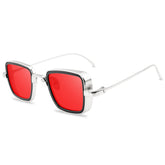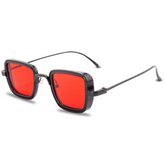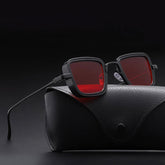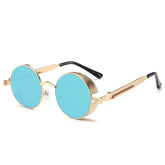Anthony Lee - Nov 28, 2022
What is PD And How to Measure It?
Most people know that they need to visit an optometrist or ophthalmologist to get a prescription for glasses or contacts. But what many don't know is what exactly the letters and numbers on their prescription mean. In this article, we'll explain '"what does PD mean, or what is pupillary distance and how to measure it".

What is (PD) Pupillary Distance?
Pupillary distance (PD) is the distance in millimeters between the centers of the pupils in each eye. It's important for eyeglass wearers to know their PD because it helps eyeglass prescription writers determine the correct lens power and placement of the optical center of the lenses. A PD that's too small or too large can cause vision problems.
How to Measure Your Pupillary Distance By Yourself?
If you've ever gone shopping for glasses, you know that one of the most important measurements is your pupillary distance, or the distance between the center of your pupils. But what if you don't have access to an optometrist? In this article, we'll show you how to measure your pupillary distance by yourself.
Measuring your pupillary distance is important for ordering glasses or contacts. Here are a few steps on how to measure your pupillary distance with a ruler:
1. Find a friend or family member to help you with this task.
2. Sit in a well-lit room and position the ruler horizontally above your nose bridge.
3. Close your right eye and sight along the left edge of the ruler until the ruler lines up with the center of your left pupil.
PD Measurements
There is no gold standard when it comes to measuring PD, but there are a few main methods that are commonly used. The most common method is the use of an eye chart, which measures the ability to see at various distances. Another common method is the use of a retinal camera, which takes pictures of the back of the eye.
Far Pd
Far PD is a type of eyeglass that is designed for people who need vision correction for activities such as driving or watching television. Far PD is not meant for reading glasses or glasses that are only used for computer work. This type of glass is made with a special material that helps to reduce the amount of glare that can be caused by bright lights.
Near Pd
Your "near PD" is short for your pupillary distance. It's the distance between the center of your two pupils, and it's measured in millimeters.
Why is this measurement important? Well, if you're getting new reading glasses, your optometrist or ophthalmologist will use your near PD to figure out the best prescription for you.
That's because the distance between your pupils can affect how well you see things up close.
Generally speaking, a near PD of 55-60 mm is considered average. But it's not uncommon for people to have a near PD that falls outside of that range.
Binocular Pd
The average person has a binocular PD—or pupillary distance—of around 2.5 inches. Binocular PD is the distance between your pupils when looking at an object with both eyes.
Monocular Pd (from Pupil to Bridge)
Monocular PD is a condition where one eye has poor vision. It is usually caused by an injury or disease to the eye. Treatment for monocular PD usually involves surgery to improve the vision in the affected eye.
Is PD Important?
As someone who works in the medical field, you know that PD, or Parkinson’s disease, is an important topic. But why is PD important? Here are a few reasons:
1. PD is a debilitating disease that affects millions of people worldwide.
2. PD can lead to physical and cognitive decline, making it difficult for patients to live independently.
3. There is no cure for PD, so early diagnosis and treatment are essential.
4. PD can be expensive to treat, so understanding the disease and its effects is critical.
5. PD research is constantly evolving, so it’s important to stay up-to-date on the latest findings.
6. There are many different types of PD, so it’s important to be able to recognize the symptoms of each one.
7.
FAQ
Can I Find My PD on My Glasses?
Yes, your pupillary distance (PD) is typically printed on the inside of your eyeglass frames. It’s the measurement in millimeters between the center of one pupil to the center of the other. This number is important because it helps your eye care professional determine where to place the lenses in your glasses so that you can see clearly. If you’re ordering glasses online, you’ll need to measure your PD before you can checkout.
How to Read My PD on My Prescription?
Most people have a PD that falls somewhere between 54 and 74 millimeters. To find yours, look at the box labeled “OD” (right eye) and “OS” (left eye) on your prescription.
Does PD Change over Time
Yes, pupillary distance does change over time. The average person's pupillary distance will increase by about 0.5 mm per year. This may not seem like much, but over the course of a lifetime, it can add up to a significant change. There are a few factors that can influence how much your pupillary distance changes. Age is the most important factor, but refractive error and residual myopia can also play a role.
What if PD is off by 2mm
If your pupillary distance is off by 2mm, it could mean that you're not seeing as clearly as you could be. This is because the pupil is the black part of the eye that allows light in. The iris is what gives your eye its color. When light hits the back of your eye, it's focused through the pupil and onto the retina. If your pupillary distance is off, the light may not be hitting the retina directly, which can cause blurriness.
PD Measurement App
You can find pd measurement apps on Apple store. For example, EyeMeasure and GlassesOn.

Anthony Lee
freelance writer
Written by: Anthony Lee
Anthony Lee is a freelance writer who works as a sales clerk in an eyewear boutique, and her seven years of experience allows her to select the right eyewear for her customers at a glance. Knowing the whole process of eyewear production, she also has a unique perspective on eyewear fashion. She is passionate about fashion accessories and life. She likes to match a variety of eyewear with various styles of clothing.
Our Blog's Categories
“ Everything you want to know about eyeglasses. You will know how to select functional glasses”
Guide and Learn

“ You will get the latest discount activities here. If you are fan of giveaways, you can't miss it. ”
Events

“ If you want to find which brand your favorite icon wears, you can check it here. ”
Celebrities with Glasses

“Don't know which glasses frame fits you? This collection will solve your problems. ”













